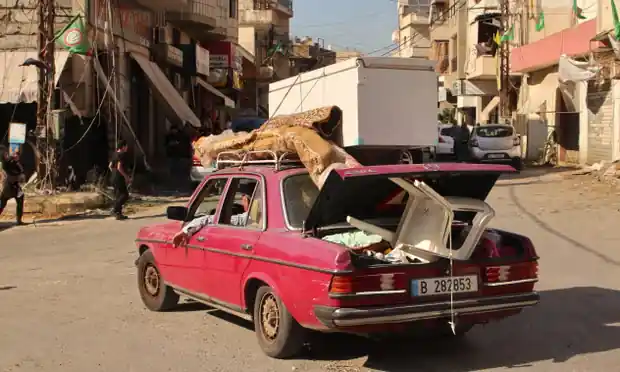Tyre, Lebanon – Zainab Barakat’s morning began with the roar of bombs shaking her village of Zebqine, near the Lebanese-Israeli border.
The violent clashes between Hezbollah and the Israel Defense Forces (IDF) have escalated significantly, transforming her once-quiet village into a scene of devastation.
“It was right on top of us. It smashed the windows; the whole place shook. The children were panicking,” Barakat recounted.
This recent surge in violence marks the fiercest fighting since the hostilities began in October, with the IDF deploying 100 jets and Hezbollah firing over 340 rockets.
For Barakat and her family, this bombardment was the final straw. They fled to Tyre, a coastal city 17 kilometers away, joining the increasing number of displaced people in Lebanon.
In the past month alone, the number of displaced individuals has surged from 99,000 to 112,000, a trend that is expected to continue as the conflict spreads to new areas like the eastern Bekaa Valley and southern suburbs of Beirut.
The International Organization for Migration (IOM) warns that this figure might rise further as more people are forced to flee.
Tyre, now hosting nearly 30,000 displaced persons, faces an overwhelming humanitarian challenge. The city, once known for its rich history and stunning coastal views, has become a focal point for the displacement crisis.
Local shelters, such as the one where Barakat and her family sought refuge, are stretched thin. Tyre’s municipality has taken in 309 families across five shelters, with thousands more in temporary housing.
Yet, the response to this crisis is faltering. Major donors supporting Tyre’s relief efforts have dwindled from 51 to just five since the conflict began.
This reduction in aid has led to severe cutbacks. Mortada Mhanna, the shelter manager, explained, “Nobody expected it would last this long.
They expected one week, two weeks, but not a year.” Consequently, the shelter has had to reduce hot meals from three a day to just one.
Hans Bederski of World Vision, one of the remaining supporters, emphasized the dire situation: “What we are providing as the international community is not enough. We are set up just to provide the basics for survival: food and a roof over people’s heads, and even that is stretched.”
The organization is struggling to maintain essential services such as education and psychosocial support for children traumatized by the ongoing violence.
The displacement crisis is not only about immediate needs but also about the broader impact on Lebanese society. Christina Abou Rouphaël of the Beirut-based thinktank Public Works has observed a troubling trend: “There is exploitation of the crisis by landlords, real estate companies, and brokers.”
The influx of displaced people has driven up rental prices, leaving many struggling to afford basic housing. The IOM warns that as displaced families’ savings dwindle, more will be forced into shelters or face severe economic hardship.
Lebanon’s economic crisis, already severe before the current conflict, has been exacerbated by the ongoing fighting. The Lebanese government estimates that the war has inflicted an additional $10 billion in damages, more than a third of the country’s GDP.
This economic strain compounds the difficulties faced by displaced families who, despite their dire circumstances, receive little to no support from government or NGOs.
The situation for those in displacement shelters is particularly harsh. Faten Khaled, who fled her home village of Yarine on October 15, shares her experience. Her family expected a short-term displacement but has now been living in a shelter for over ten months.
“We thought we would be gone for a week, a month at most, and then we’d be back,” Khaled said. Her family of six, reliant on a meager $200 monthly stipend from Hezbollah, struggles to make ends meet. They have not received any other form of aid.
Khaled’s situation is emblematic of the broader challenges faced by displaced families. Many have been forced to leave their homes, which are now uninhabitable due to the heavy fighting.
Villages close to the border, like Yarine, have been heavily damaged, with entire areas reduced to rubble. The conflict has created a “dead zone” along the border, further complicating the return of displaced residents.
In addition to the physical destruction, the psychological toll on displaced individuals is profound. The prolonged nature of the conflict has led to severe emotional and mental health challenges.
Children, who have spent months out of school, face particular difficulties. The strain on parents trying to provide for their families under these conditions only adds to the crisis.
The international community’s response has been insufficient in addressing the scale of the humanitarian needs. While some aid organizations continue their efforts, the decrease in major donors and the ongoing economic crisis in Lebanon pose significant obstacles.
The IOM and other agencies are working tirelessly to address the immediate needs of displaced individuals, but the long-term outlook remains uncertain.
As Lebanon marks nearly a year of intense conflict, the humanitarian situation grows increasingly dire. Displaced families like Barakat’s and Khaled’s face a future marked by uncertainty and hardship.
The international community’s support, though crucial, remains limited and inadequate to fully address the scale of the crisis.
With no end in sight to the conflict, the plight of Lebanon’s displaced population is set to continue as the country grapples with one of its most severe humanitarian crises in recent history.

